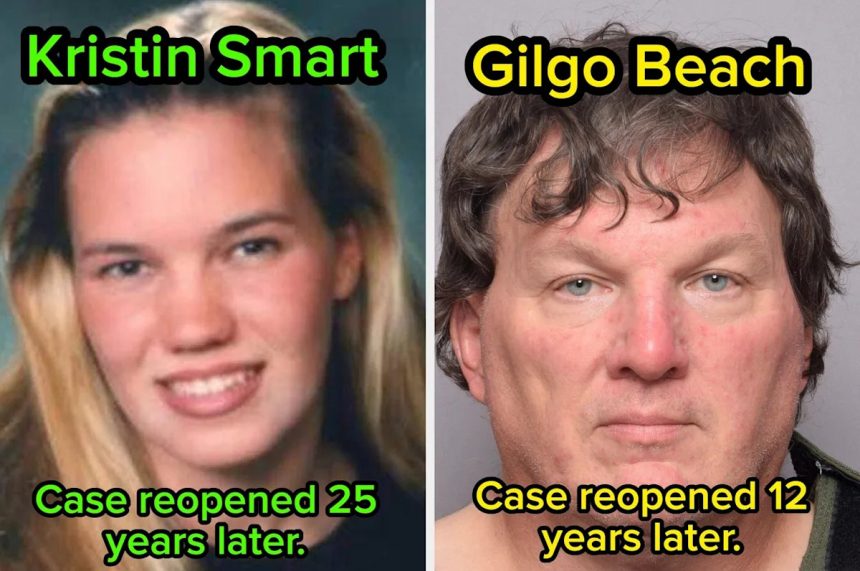Warning: Graphic content ahead, including stories of sexual assault and murder.
1. Theresa Fusco (1984, New York) — Case reopened roughly 40 years later.
Trigger for Reopening: New DNA review (2020s)Outcome / Current Status: Suspect indicted in 2025
Sixteen-year-old Theresa Fusco vanished in November 1984, after leaving her job at a roller-skating rink in Lynbrook, New York. Her nude body was found weeks later, in early December, buried under leaves in nearby woods, having been sexually assaulted and strangled.

In 1986, three men were convicted of her murder, but their convictions were overturned in 2003 after advanced DNA testing excluded them.

The case was formally reopened in early 2024, when investigators began surveilling a new suspect after developing “multiple investigative leads” and later recovered a discarded smoothie cup and straw he had used.

On Oct. 15, 2025, authorities announced that 63-year-old Richard Bilodeau had been indicted for the crime based on a DNA match from the straw retrieved. Bilodeau, who was living with his grandparents in Lynbrook at the time of the murder, pleaded not guilty and faces up to 25 years to life if convicted.

2. Leslie Preer (2001, MD) — Case reopened over 20 years later.

Trigger for Reopening: DNA genealogy (2022)Outcome / Current Status: Suspect pleaded guilty and was sentenced to 22 years (2025)
Leslie Preer, a mother and wife living in the Chevy Chase, Maryland area, was found strangled and with severe head trauma in her home in May 2001. For decades, detectives pursued dozens of leads that went nowhere, and her family watched the case fade into cold-case status. Then, in 2022, advances in forensic genealogy breathed new life into the investigation.

By tracing a partial DNA sample from the crime scene through a public genealogy database, investigators identified a distant relative of the killer. The trail eventually led to a former neighbor who had lived just blocks away from Leslie at the time of her murder.

In 2025, the suspect — Eugene Gligor, who years earlier had dated Leslie’s daughter, Lauren Preer — pleaded guilty to second-degree murder. At sentencing, Gligor claimed he had “blacked out” due to alcohol and cocaine use, remembered entering Preer’s house, but could not explain why he killed her. He was sentenced to 22 years in prison in August 2025.

3. Pamela Conyers (1970, MD) — Case reopened 52 years later.

Trigger for Reopening: Forensic genealogyOutcome / Current Status: Identified two deceased suspects (2023–2024)
Sixteen-year-old Pamela Lynn Conyers disappeared in October 1970 after attending a pep rally at Glen Burnie High School. Four days later, her body was discovered in a wooded area off Route 100 in Anne Arundel County. The case haunted investigators for more than half a century.

In 2023, detectives used forensic genealogy to reexamine DNA evidence from the original investigation. That work identified Forrest Clyde Williams III — who had died in 2018 — as a primary suspect. A year later, in 2024, police named a second deceased suspect, Donald Willard, after further genealogical analysis.
Anne Arundel County Department of Corrections / Via aacounty.org
Although both men are deceased and cannot be charged, authorities say the case remains open as they continue reviewing its history. Investigators noted that there is no evidence to suggest that Forrest Clyde Williams III or Donald Willard knew Pamela Lynn Conyers, and they are continuing to investigate any possible association or link between them.
4. Kristin Smart (1996, CA) — Case reopened 25 years later.

ZUMA Press Inc / Alamy
Trigger for Reopening: Renewed media attention and podcastOutcome / Current Status: Paul Flores convicted and sentenced (2023)
In May 1996, Cal Poly student Kristin Smart vanished after a college party in San Luis Obispo. Despite intense searches and national coverage, no trace of her was found, and the case went cold for decades. Her disappearance became one of California’s most infamous unsolved mysteries.

ZUMA Press Inc / Alamy
In 2019, the true-crime podcast Your Own Backyard reexamined the case, sparking new witness tips and renewed law enforcement interest. Detectives dug into old files and eventually focused again on Paul Flores, a fellow student who had been the last person seen with Kristin.

ZUMA Press Inc / Alamy
After searches uncovered forensic evidence consistent with human blood near Flores’s home, he was charged in 2021 and convicted in 2022 of her murder. In March 2023, he was sentenced to 25 years to life in prison. Her body has still never been found, but the verdict finally gave her family the justice they had waited nearly 30 years to see.

ZUMA Press Inc / Alamy
5. Michelle Martinko (1979, IA) — Case reopened 39 years later.

Trigger for Reopening: Genetic genealogy (2018)Outcome / Current Status: Jerry Burns convicted (2020)
Eighteen-year-old Michelle Martinko was found brutally stabbed to death inside her family’s Buick in the parking lot of a Cedar Rapids mall just before Christmas 1979. The killing shocked the quiet Iowa town, and for decades, investigators had little more than a blood sample from the car as evidence.

Then in 2018, cold-case detectives submitted that sample for genetic genealogy testing — a relatively new investigative tool that compares DNA to public ancestry databases. The results pointed to a man named Jerry Burns, who had never appeared on police radar before.

After obtaining a DNA sample from a straw he discarded, investigators confirmed the match. Burns was arrested nearly 40 years after the crime and, in 2020, a jury found him guilty of first-degree murder. He was sentenced to life in prison without the possibility of parole, closing one of Iowa’s most haunting cold cases.

6. April Tinsley (1988, IN) — Case reopened 30 years later.

Trigger for Reopening: Genealogy and DNA phenotypingOutcome / Current Status: John Miller confessed (2018)
Eight-year-old April Tinsley disappeared while walking home from a friend’s house in Fort Wayne, Indiana, in April 1988. Her body was found three days later in a ditch 20 miles away. Over the next three decades, her killer taunted police and the public — even leaving chilling notes near children’s bicycles, claiming responsibility.

The case broke open in 2018 when detectives combined DNA phenotyping (which generated composite sketches from genetic material) with forensic genealogy to trace the suspect’s family line. The investigation led to John D. Miller, a local factory worker whose discarded trash provided a DNA match.

When confronted, Miller confessed to abducting, raping, and murdering April. He pleaded guilty in December 2018 and was sentenced to 80 years in prison (two consecutive 40-year terms) — ending a 30-year nightmare that had haunted the Fort Wayne community. Miller died in prison in September 2025.

7. Michella Welch (1986, WA) — Case reopened 32 years later.

Trigger for Reopening: DNA genealogyOutcome / Current Status: Gary Hartman convicted (2024)
In March 1986, 12-year-old Michella Welch was abducted from Puget Park in Tacoma, Washington, while riding her bike. Her body was discovered hours later in a nearby ravine, showing signs of sexual assault and blunt-force trauma. Despite tireless efforts, the case grew cold as the years passed.

In 2018, the Tacoma police partnered with forensic genealogy experts to reanalyze DNA from the crime scene. Using family-tree data and historical records, investigators traced the genetic material to Gary Charles Hartman, a nurse who had lived near the park at the time. Detectives collected his DNA from a discarded napkin, confirming the match.

Hartman was arrested in 2018 and, after a lengthy pre-trial process, was convicted in 2022 of first-degree murder and first-degree rape. He was sentenced to life in prison without parole, bringing long-awaited justice nearly four decades after Michella’s murder.

8. Jennifer Bastian (1986, WA) — Case reopened 32 years later.

Trigger for Reopening: DNA match from genealogyOutcome / Current Status: Robert Washburn pled guilty (2019)
Thirteen-year-old Jennifer Bastian vanished on Aug. 4, 1986, while riding her bike through Point Defiance Park in Tacoma, Washington — just four months after 12-year-old Michella Welch had been abducted and killed nearby. The eerie similarities between the two cases led investigators and the public to believe for decades that the same person was responsible.

In 2018, however, advances in forensic testing finally distinguished the DNA evidence from the two murders. The new analysis revealed that the crimes were unrelated and pointed investigators toward a new suspect in Jennifer’s case. Using forensic genealogy, detectives identified Robert Dwane Washburn, a retired mechanic who had once even volunteered tips about the case to police. After collecting his DNA from a discarded paper cup, they confirmed the match.

Washburn pleaded guilty in May 2019 to Jennifer’s murder and was sentenced to 26 years and 6 months in prison. His confession — and the DNA evidence that separated the two long-linked cases — finally brought closure to one of Tacoma’s most haunting double mysteries.

Tacoma News Tribune / Tribune News Service via Getty Images
9. Sherri Rasmussen (1986, CA) — Case reopened 23 years later.

Trigger for Reopening: Cold-case DNA reviewOutcome / Current Status: Stephanie Lazarus convicted (2012)
Sherri Rasmussen, a 29-year-old hospital nursing director, was found beaten and shot to death in her Los Angeles condo in 1986. Detectives initially ruled the crime a botched burglary — but Sherri’s family suspected otherwise, especially given her tense relationship with her husband’s ex-girlfriend, LAPD officer Stephanie Lazarus.

For decades, the case sat dormant. Then in 2009, a cold-case DNA review revealed something shocking: the saliva on a bite mark left on Sherri’s arm matched Lazarus’s DNA. Investigators quietly built their case, gathering her genetic material from a discarded cup.

Lazarus was arrested inside LAPD headquarters and, in 2012, was convicted of first-degree murder and sentenced to 27 years to life in prison. The revelation that one of their own had killed Sherri Rasmussen sent shockwaves through the Los Angeles Police Department and remains one of the most infamous cases of police-involved homicide in US history.

10. Lindy Sue Biechler (1975, PA) — Case reopened 47 years later.

Trigger for Reopening: Forensic genealogyOutcome / Current Status: David Sinopoli pleaded guilty (2023)
Nineteen-year-old Lindy Sue Biechler was found stabbed to death in her Lancaster, Pennsylvania, apartment on Dec. 5, 1975, just before Christmas. Investigators collected DNA and cigarette butts from the scene, but no suspect emerged despite decades of effort and hundreds of interviews.

In 2022, using advanced forensic-genealogy techniques, detectives traced the crime-scene DNA to David Sinopoli, an 80-year-old Lancaster man who had lived in the same apartment complex as Lindy Sue at the time of her murder. Police confirmed the match using DNA he discarded in a coffee cup at Philadelphia International Airport, and arrested him nearly half a century later.

Sinopoli pleaded guilty in December 2023 to third-degree murder and was sentenced to 25–50 years in prison.

11. Carla Walker (1974, TX) — Case reopened 46 years later.

Trigger for Reopening: Advanced DNA testingOutcome / Current Status: Glen McCurley pled guilty and was sentenced (2021)
Seventeen-year-old Carla Walker was kidnapped from her boyfriend’s car after a high-school Valentine’s dance in Fort Worth, Texas, on Feb. 17, 1974. Her body was found three days later in a culvert near Benbrook Lake, brutally beaten, sexually assaulted, and strangled. Despite hundreds of leads and national attention, the case went cold for decades.

In 2020, a new team of detectives reexamined a small DNA sample preserved from Carla’s clothing. Using advanced testing unavailable in the 1970s, they identified a genetic profile matching Glen Samuel McCurley, a local man who had been questioned in 1974 but never charged. When investigators obtained DNA from his household trash, the match was confirmed.

McCurley, then 78, pleaded guilty in August 2021 during his trial and was sentenced to life in prison. He died in custody in June 2024.

12. Mandy Stavik (1989, WA) — Case reopened 28 years later.

Trigger for Reopening: Familial DNA testOutcome / Current Status: Timothy Bass convicted and sentenced (2019)
Eighteen-year-old Mandy Stavik disappeared while jogging near her home in rural Washington the day after Thanksgiving in 1989. Her body was found days later in a nearby river.

Nearly three decades later, detectives received a crucial tip from a former coworker of Timothy Bass, who told police he had made unsettling comments about the case and acted secretive about his belongings. Bass had lived less than a mile from Mandy’s home in 1989, and investigators believed he abducted her while she was jogging past his house. When they collected DNA from a plastic cup Bass had used, it matched semen recovered from the victim.

Investigators said the attack appeared to be sexually motivated and opportunistic, with no prior connection between Bass and Mandy. Bass was convicted in May 2019 of first-degree murder and sentenced to 26½ years in prison.

13. “Boy in the Box” / Joseph Augustus Zarelli (1957, PA) — Case reopened 65 years later.

Archive PL / Alamy
Trigger for Reopening: Forensic genealogy (2022)Outcome / Current Status: Victim identified as Joseph Zarelli (2022)
In February 1957, the body of a small boy was discovered wrapped in a blanket inside a cardboard box in northeast Philadelphia. He was between 4 and 6 years old, malnourished, and badly beaten — but no one ever came forward to claim him. The mystery of the “Boy in the Box” haunted generations, becoming one of America’s most famous unsolved cases.
Archive PL / Alamy
For decades, detectives and amateur sleuths tried to give the boy back his name. Then, in December 2022, forensic genealogists finally did. Through painstaking DNA analysis and family-tree reconstruction, investigators identified him as Joseph Augustus Zarelli, born in 1953. In 2024, authorities also confirmed the identities of his parents, though both are now deceased and are not considered suspects.

The case remains open as police work to determine who killed Joseph and why. After 65 years of silence, his name is finally known — a small but profound victory in one of the nation’s oldest cold-case homicides.
14. Stephen Lawrence (1993, UK) — Case reopened 18 years later.

James Boardman Archive / Alamy
Trigger for Reopening: Legal reform and cold-case reviewOutcome / Current Status: Two men convicted and sentenced (2012)
Eighteen-year-old Stephen Lawrence was murdered in a racially motivated attack while waiting for a bus in Eltham, southeast London, on April 22, 1993. The original investigation was marred by police mishandling and institutional racism, sparking national outrage and leading to the landmark Macpherson Report (1999), which exposed systemic racism in the Metropolitan Police.

john angerson / Alamy
After years of tireless campaigning by Stephen’s parents, a 2010 forensic review uncovered microscopic blood, fibers, and hair linking two longtime suspects — Gary Dobson and David Norris — to the crime scene.

James Boardman / Alamy
Both men were convicted in January 2012 of murder and sentenced to life in prison, nearly two decades after Stephen’s death.
15. Etan Patz (1979, NY) — Case reopened 31 years later.

ZUMA Press, Inc. / Alamy
Trigger for Reopening: Renewed DA investigationOutcome / Current Status: Pedro Hernandez’s 2017 conviction overturned; new trial ordered (2025)
Six-year-old Etan Patz vanished on his way to the school bus in Manhattan on May 25, 1979, becoming one of the first missing children to have his photo printed on milk cartons. His disappearance changed how America viewed child safety — but for decades, the case remained unsolved.

In 2010, Manhattan prosecutors reopened the investigation with fresh eyes, re-interviewing witnesses and pursuing long-dismissed leads. Two years later, Pedro Hernandez, who had worked at a nearby bodega, confessed to luring Etan into a basement and killing him.

Although Etan’s body was never found, Hernandez was convicted in 2017 of murder and kidnapping and sentenced to 25 years to life.

In 2025, however, a federal appeals court overturned the conviction and ordered a new trial, ruling that his confession should have been suppressed due to concerns about his mental competency. The case remains open, continuing to haunt New York and the nation more than four decades after Etan’s disappearance.

16. Cheryl Grimmer (1970, Australia) — Case reopened 46 years later.

Trigger for Reopening: Reopened police inquiryOutcome / Current Status: Charges dropped (2019); case remains unsolved
Three-year-old Cheryl Gene Grimmer vanished from Fairy Meadow Beach near Wollongong, New South Wales, on Jan. 12, 1970, moments after her mother and brothers stepped into a nearby shower block. Despite frantic searches and nationwide attention, no trace of her was ever found.

The case haunted New South Wales for decades. In 2016, detectives reopened the investigation and uncovered a long-forgotten police statement from a teenage boy who had confessed to killing Cheryl in 1971 — though he was never charged because his confession was ruled inadmissible as he was an underage 17-year-old questioned without a parent or lawyer present, and the judge found the interview unfair and unreliable. After reexamining the evidence, police identified the same man, known as “Mercury,” now in his 60s, as a suspect and charged him in 2017 with Cheryl’s abduction and murder.

In 2019, a judge again ruled the confession inadmissible, leading to the charges being dropped. In October 2025, a New South Wales politician publicly named the suspect in parliament and read out his previously hidden confession, bringing the case back into the spotlight and putting pressure on police to reopen the investigation.
17. Finally, the Gilgo Beach serial killings (2010, NY) — Case reopened 12 years later.

ZUMA Press, Inc. / Alamy
Trigger for Reopening: Task force reboot (2022)Outcome / Current Status: Rex Heuermann arrested and charged (2023), trial set for 2026
Between 2010 and 2011, the remains of at least 10 victims — mostly women connected to the sex trade — were discovered along a stretch of Ocean Parkway near Gilgo Beach on Long Island, New York. Despite massive media attention and multiple investigative efforts, the case went cold for more than a decade.

Storms Media Group / Alamy
In 2022, a new inter-agency task force reexamined digital and physical evidence with advanced forensic tools. Investigators used cellphone records, surveillance footage, and DNA from a discarded pizza box to identify Rex Heuermann as the prime suspect. Heuermann was arrested in July 2023 and charged with multiple murders.

ZUMA Press Inc / Alamy
By 2025, prosecutors had charged Heuermann with seven murders in total, and a judge ruled that all charges will be tried together in a single consolidated trial scheduled for 2026. The court has also approved the use of cutting-edge whole-genome DNA evidence linking Heuermann to several victims — a major precedent in New York forensic law. The investigation into additional possible victims continues.

ZUMA Press, Inc. / Alamy
Love this kind of content? Subscribe to the That Got Dark newsletter to get more like it delivered RIGHT to your inbox!
Also in In the News: Trump Accidentally Burned Himself With His Own Question, And People Cannot Stop Laughing
Also in In the News: Karoline Leavitt’s Unbelievable New Claim About Trump Has Already Backfired, And The Internet Is Having A Field Day With It
Also in In the News: A Clip Of Donald Trump Getting Angry After Being Fact-Checked Is Going Mega Viral, And It Sums Up His Entire Presidency In A Nutshell









